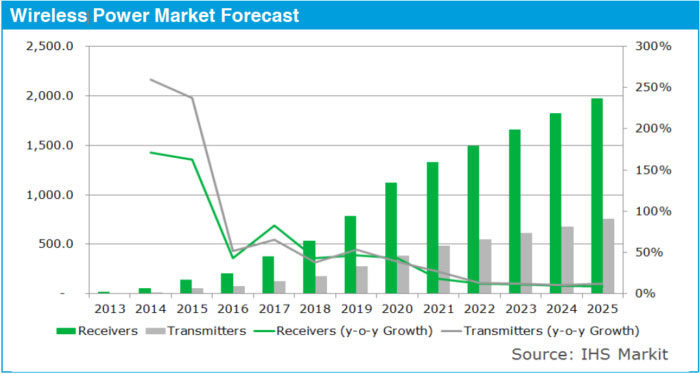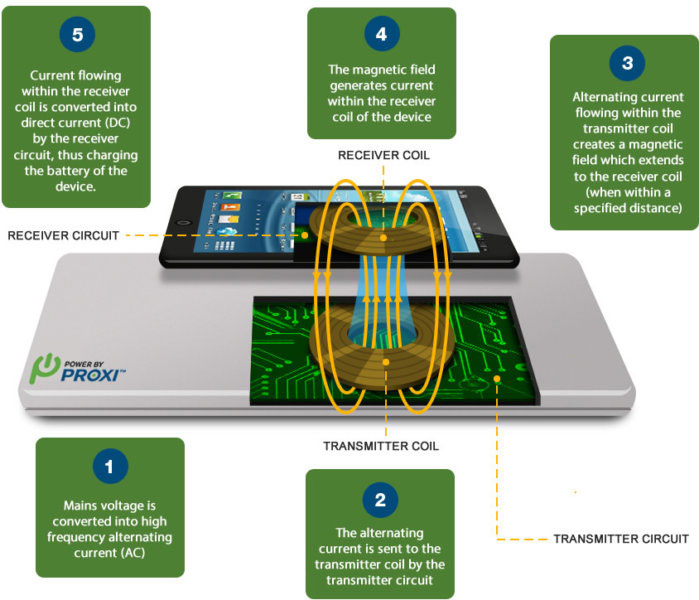Wireless charging explained: What is it and how does it work?
By Lucas Mearian
Senior Reporter, Computer world
Wireless charging has been around since the late 19th century, when electricity pioneer Nikola Tesla demonstrated magnetic resonant coupling – the ability to transmit electricity through the air by creating a magnetic field between two circuits, a transmitter and a receiver.
But for about 100 years it was a technology without many practical applications, except, perhaps, for a few electric toothbrush models.
Today, there are nearly a half dozen wireless charging technologies in use, all aimed at cutting cables to everything from smart phones and laptops to kitchen appliances and cars.
Wireless charging is making inroads in the health care, automotive and manufacturing industries because it offers the promise of increased mobility and advances that could allow tiny internet of things (IoT) devices to get power many feet away from a charger.

The wireless charging circuit board used for Ossia's Cota RF technology, which can send power over distances greater than 15 feet.
The most popular wireless technologies now in use rely on an electromagnetic field between a two copper coils, which greatly limits the distance between a device and a charging pad. That's the type of charging Apple has incorporated into the iPhone 8 and the iPhone X.
How wireless charging works
Broadly speaking, there are three types of wireless charging, according to David Green, a research manager with IHS Markit. There are charging pads that use tightly-coupled electromagnetic inductive or non-radiative charging; charging bowls or through-surface type chargers that use loosely-coupled or radiative electromagnetic resonant charging that can transmit a charge a few centimeters; and uncoupled radio frequency (RF) wireless charging that allows a trickle charging capability at distances of many feet.
Both tightly coupled inductive and loosely-coupled resonant charging operate on the same principle of physics: a time-varying magnetic field induces a current in a closed loop of wire.

Ikea's wireless charger line-up, which includes a pad that's capable of charging three devices at once (center).
It works like this: A magnetic loop antenna (copper coil) is used to create an oscillating magnetic field, which can create a current in one or more receiver antennas. If the appropriate capacitance is added so that the loops resonate at the same frequency, the amount of induced current in the receivers increases. This is resonant inductive charging or magnetic resonance; it enables power transmission at greater distances between transmitter and receiver and increases efficiency. Coil size also affects the distance of power transfer. The bigger the coil, or the more coils there are, the greater the distance a charge can travel.
In the case of smart phone wireless charging pads, for example, the copper coils are only a few inches in diameter, severely limiting the distance over which power can travel efficiently.
But when the coils are larger, more energy can be transferred wirelessly. That's the tactic WiTricity, a company formed from research at MIT a decade ago, has helped pioneer. It licenses loosely-coupled resonant technology for everything from automobiles and wind turbines to robotics.
In 2007, MIT physics professor Marin Soljačić proved he could transfer electricity at a distance of two meters; at the time, the power transfer was only 40% efficient at that distance, meaning 60% of the power was lost in translation. Soljačić started WiTricity later that year to commercialize the technology, and its power-transfer efficiency has greatly increased since then.
In WiTricity's car charging system, large copper coils – over 25 centimeters in diameter for the receivers – allow for efficient power transfer over distances up to 25 centimeters. The use of resonance enables high levels of power to be transmitted (up to 11kW) and high efficiency (greater than 92% end-to-end), according to WiTricity CTO Morris Kesler. WiTricity also adds capacitors to the conducting loop, which boosts the amount of energy that can be captured and used to charge a battery.
The system isn't just for cars: Last year, Japan-based robotics manufacturer Daihen Corp. began shipping a wireless power transfer system based on WiTricity's technology for automatic guided vehicles (AGVs). AGVs equipped with Daihen's D-Broad wireless charging system can simply pull up to a charging area to power up and then go about their warehouse duties.
While charging at a distance has big potential, the public face of wireless charging has until now remained with charging pads.

"In terms of progress and industry readiness, charging pads have been shipping in volume since 2015; charging bowls/through-surface type are really just launching this year; and charging across a room is probably still at least a year away from commercial high-volume reality–- although the new Energous products show this method working over very short range right now, e.g., a couple of centimeters," Green said.
Just over 200 million wireless charging-enabled devices shipped in 2016, with almost all of them using some form of inductive (charging pad) type design.
In September, Apple finally chose a side after lagging behind other handset manufacturers for years by embracing WPC's Qi standard, the same that Samsung and other Android smartphone makers have been using for at least two years.
The first class of mobile device wireless chargers emerged a six or so years ago; they used tightly coupled or inductive charging, which requires users to place a smartphone in an exact position on a pad for it to charge.
"In my mind, lining it up exactly to charge doesn't save you a lot of effort from just plugging it in," said Benjamin Freas, principal analyst for Navigant Research.
While early adopters and techies bought into inductive charging, others did not, Freas said.

Belkin's BoosUp wireless charging pad is similar to others in that it contains a copper transmitter charging, a chipset to control the power delivered to a device, and foreign object detection technoogy to ensure objects that shouldn't recieve a charge don't.
In September 2012, the Nokia 920 became the first commercially available smart phone to offer built-in wireless charging capabilities based on the Qi specification.

How wireless charging works.
The current mobile phones which have wireless charger function as below:

If your mobile phones are without wireless charger function, do not worry, you can put the matched wireless charging receiver to your phone, then you can use wireless charger to charge your phone normally.




